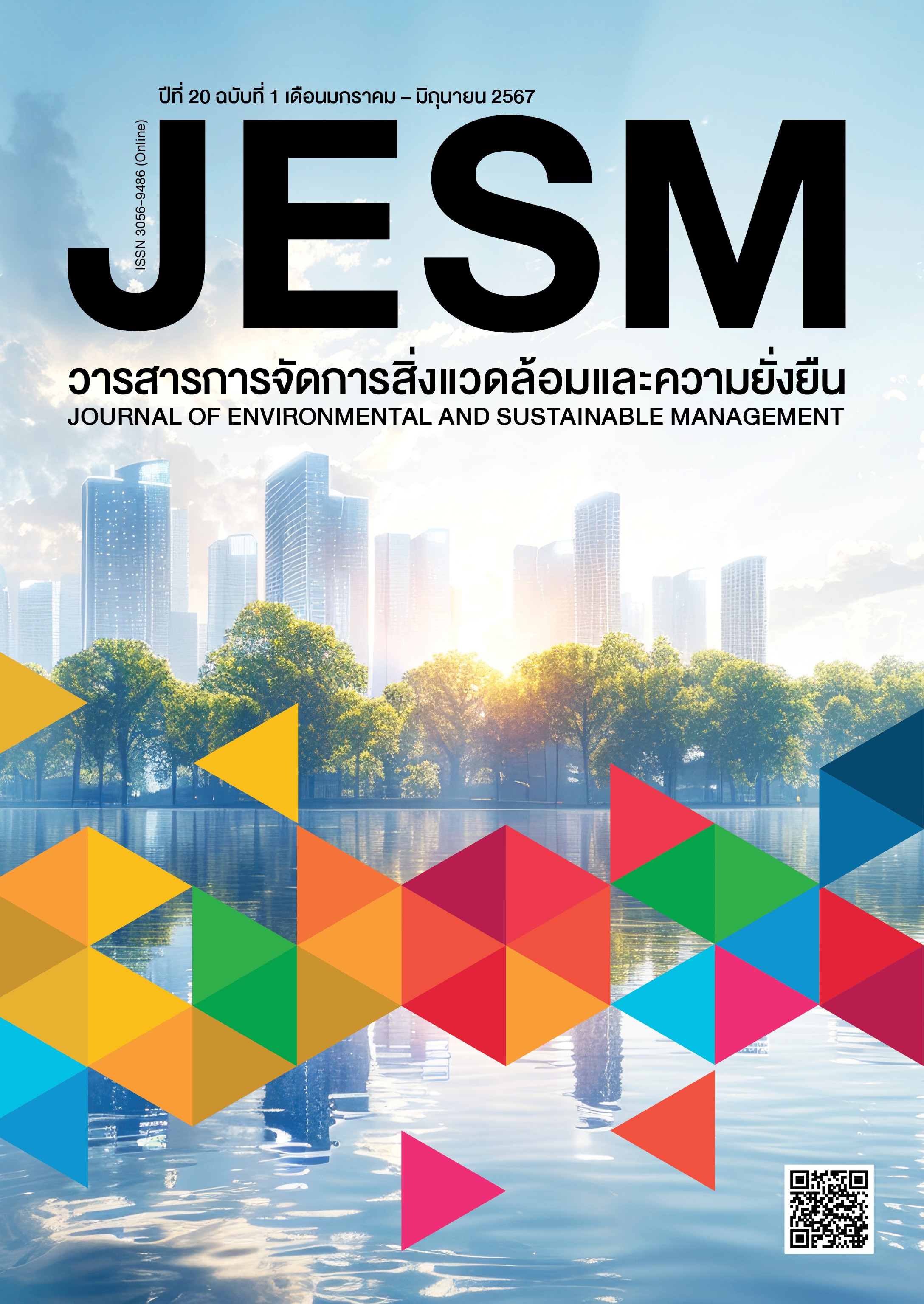แนวทางการบริหารที่ส่งเสริมความสำเร็จของโรงเรียนสิ่งแวดล้อมศึกษาเพื่อการพัฒนาที่ยั่งยืน สังกัดสำนักงานเขตพื้นที่การศึกษามัธยมศึกษากรุงเทพมหานคร เขต 2
DOI:
https://doi.org/10.14456/jesm.2024.2คำสำคัญ:
การบริหาร, สิ่งแวดล้อมศึกษา, การพัฒนาที่ยั่งยืน, โรงเรียนสิ่งแวดล้อมศึกษาเพื่อการพัฒนาที่ยั่งยืนบทคัดย่อ
การวิจัยมีวัตถุประสงค์ คือ 1) เพื่อวิเคราะห์ข้อมูลเชิงประจักษ์ของปัจจัยเชิงสาเหตุในการบริหาร และ 2) เพื่อศึกษาแนวทางการบริหารที่ส่งเสริมความสำเร็จของโรงเรียนสิ่งแวดล้อมศึกษาเพื่อการพัฒนาที่ยั่งยืน สังกัดสำนักงานเขตพื้นที่การศึกษามัธยมศึกษากรุงเทพมหานคร เขต 2 รูปแบบของการวิจัยเป็นแบบผสมผสาน สุ่มตัวอย่างแบบชั้นภูมิ ตามขนาดโรงเรียน จากคณะกรรมการที่ดำเนินการโรงเรียนสิ่งแวดล้อมศึกษาเพื่อการพัฒนาที่ยั่งยืน จำนวน 260 คน และผู้ให้ข้อมูลถูกเลือกแบบเจาะจง จำนวน 7 คน เครื่องมือที่ใช้ในการวิจัย คือ แบบสอบถามและแบบสนทนากลุ่ม วิเคราะห์ข้อมูลโดยใช้สถิติเชิงพรรณนา ได้แก่ ความถี่ ร้อยละ ค่าเฉลี่ย และส่วนเบี่ยงเบนมาตรฐาน แบบจำลองสมการโครงสร้าง และการวิเคราะห์เนื้อหา ผลการวิจัยพบว่า อิทธิพลทางตรงที่ส่งผลต่อความสำเร็จ คือ การจัดการเรียนรู้ของครู และ การบริหารโรงเรียนสิ่งแวดล้อมศึกษาเพื่อการพัฒนาที่ยั่งยืน โดยมีขนาดเท่ากับ 0.716 และ 0.204 ตามลำดับ และยังได้รับอิทธิพลทางอ้อมจากภาวะผู้นำของผู้บริหารสถานศึกษา โดยมีขนาดเท่ากับ 0.740 แนวทางการบริหารที่ส่งเสริมความสำเร็จของโรงเรียนสิ่งแวดล้อมศึกษาเพื่อการพัฒนาที่ยั่งยืนจากการสนทนากลุ่ม คือ 1) พัฒนาหลักสูตร กิจกรรมการจัดการเรียนรู้ และสื่อการเรียนรู้ 2) สร้างเครือข่ายสิ่งแวดล้อม นำไปสู่นวัตกรรมสีเขียว 3) ส่งเสริมประสิทธิภาพในการบริหารงบประมาณ 4) กำหนดวิสัยทัศน์ สร้างการมีส่วนร่วมและส่งเสริมคุณธรรม 5) ส่งเสริมและพัฒนาแหล่งเรียนรู้และภูมิทัศน์ และ 6) พัฒนาระบบการบริหารจัดการทรัพยากรธรรมชาติอย่างยั่งยืน
เอกสารอ้างอิง
Angsuchoti, S., Wijitwanna, S., & Pinyopanuwat, R. (2014). Statistical analysis for social and behavioral science research: LISREL techniques (4th ed.). CharoendeeMankong Printing.
Ardoin, N. M., Bowers, A. W., Roth, N. W., & Holthuis, N. (2018). Environmental education and K-12 student outcomes: A review and analysis of research.The Journal of Environmental Education, 49(1), 1-17.
Bailey, L. H. (2019). The Liberty Hyde Bailey Gardener's Companion. In The Liberty Hyde Bailey Gardener's Companion. Cornell University Press.
Burananuth, N. (2021). Evaluation of Eco-City Strategy according to Lamphun Provincial Development Plan 2018-2022 fiscal year 2020. Journal of Political Science Suan Sunandha Rajabhat University, 4(2), 108-124.
Comstock, A. B. (2020). The Comstocks of Cornell—The Definitive Autobiography. In The Comstocks of Cornell The Definitive Autobiography. Cornell University Press.
Cronbach, L. J., & Shavelson, R. J. (2004). My current thoughts on coefficient alpha and successor procedures. Educational and psychological measurement, 64(3), 391-418.
Department of Environmental Quality Promotion. (n.d.). Guidelines for operating eco-schools. DEQP.
Derman, M., & Gurbuz, H. (2018). Environmental education in the science curriculum in different countries: Turkey, Australia, Singapore, Ireland, and Canada. Journal of Education in Science Environment and Health, 4(2), 129-141.
El-Batri, B., Alami, A., Zaki, M., & Nafidi, Y. (2019). Extracurricular environmental activities in Moroccan middle schools: Opportunities and challenges to promoting effective environmental education. European Journal of Educational Research, 8(4), 1013-1028.
Gough, A. (2020). Environmental/sustainability education in a global context: Stories of political and disciplinary resistances. In Transnational Education and Curriculum Studies (pp. 99-113). Routledge.
Hair, J. F., Ringle, C. M., & Sarstedt, M. (2012). Partial least squares: the better approach to structural equation modeling?. Long range planning, 45(5-6), 312-319.
Kitipuwadon, W. (2021). Legal Measure for Air Pollution control in Thailand: Study the Effective Process Prevention, Control and Correction or Disposal of ParticulateMatter Not More Than 2.5 Microns (PM2.5) in Foreign Countries. The Journal of Law, Public Administration and Social Science. School of Law Chiang Rai Rajabhat University, 6(1), 25-46.
Li, Y., & Shapiro, J. (2020). China goes green: coercive environmentalism for a troubled planet. John Wiley & Sons.
National Economics and Social Development Council. (2018). National Strategy 2018 – 2037. NESDC.
Nuriddinovna, K. S., & Meliyevna, P. N. (2022). Characteristics of Environmental Education Issues in Avesto. International Journal of Discoveries and Innovations in Applied Sciences, 2(2), 69-72.
Office of the Basic Education Commission. (2017). Indicators and core learning content Science learning group (revised edition 2017) according to the Basic Education Core Curriculum 2008. OBEC.
Office of the Basic Education Commission. (2021). School Standards Evaluation Criteria Manual Environmental education for sustainable development. OBEC.
Office of the Basic Education Commission. (2022, 21 December). Policy and focus of the Office of the Basic Education Commission Fiscal year 2024. Announce.
Office of the Basic Education Commission. (2022). Standard Assessment Guide of Environmental Education School for Sustainable Development. OBEC.
Office of the Education Council. (2017). National Education Plan 2017 – 2036. ONEC.
Office of the Education Council. (2019). Research report: Guidelines for educational development to support environmentally friendly growth. ONEC.
Pasunon, P. (2015). Validity of questionnaires for social science research. Journal of Social Sciences Srinakharinwirot University, 18(18), 375-396.
Saosing, R., Maiorn, P., & Saetia, T. (2022). Ecotourism video production“Bang Khun Thian Mangrove Forest Learning Center”. Journal of Science and Technology,Sukhothai Thammathirat Open University. 2(1), 81-87.
Sarkulworawit, C., & Chitsawang, S. (2022). Impact Of The Covid-19 Pandemic On Illegal Transboundary Movement Of Plastic Waste In Thailand. Journal of Soc Sci & Hum. 48(1), 17-36.
Schumacker, E., & Lomax, G. (2016). A Beginner’s Guide to Structural Equation Modelling. 4th edtn.
Shutaleva, A., Nikonova, Z., Savchenko, I., & Martyushev, N. (2020). Environmental education for sustainable development in Russia. Sustainability, 12(18), 7742.
Somsombut, R., Boonprasert, U., & Siridhrungsri, P. (2020). A Model to Promote theLearning Management Environment Education for Sustainable Development in Private Vocational Colleges. Journal of MCU Peace Studies, 8(3), 1110-1124.
Sukma, E., Ramadhan, S., & Indriyani, V. (2020). Integration of environmental education in elementary schools. Journal of Physics, 1481(1), 12136.
The Secondary Educational Service Area Office Bangkok 2. (2021, 18 October). Policy and Focus points of the Bangkok Secondary Educational Service Area Office, Area 2,Fiscal Year 2022 – 2023. Announce.
Usavagovitwong, N., Sanguasinthukul, K., & Vancham, K. (2021). Green Bangkok 2030: The Case of Obligatory Delegation toward Privately-Owned Neighborhood Public Space Management. Built Environment Inquiry Journal, 20(2), 1-14.
Wattanasettanukul, P., Srisuk, C., Panthongs, W., Peerachaipawong, N., & Sinjindawong, S. (2022). Current and Desirable Conditions of Environmental Education for Sustainnable Development school (Eco-school) Under the Scondary Educational Service Area Office Bankok 2. Journal of Environmental Management, 18(2), 78-95.



